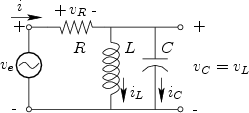 |
An inductor can be made physically using a coil of wire, and it
stores magnetic flux when a current flows through it. Figure C.2
shows a circuit in which a resistor ![]() is in series with the parallel
combination of a capacitor
is in series with the parallel
combination of a capacitor ![]() and inductor
and inductor ![]() .
.
The defining equation of an inductor ![]() is
is
Taking the Laplace transform of both sides gives
Assuming a zero initial current in the inductor at time 0, we have
